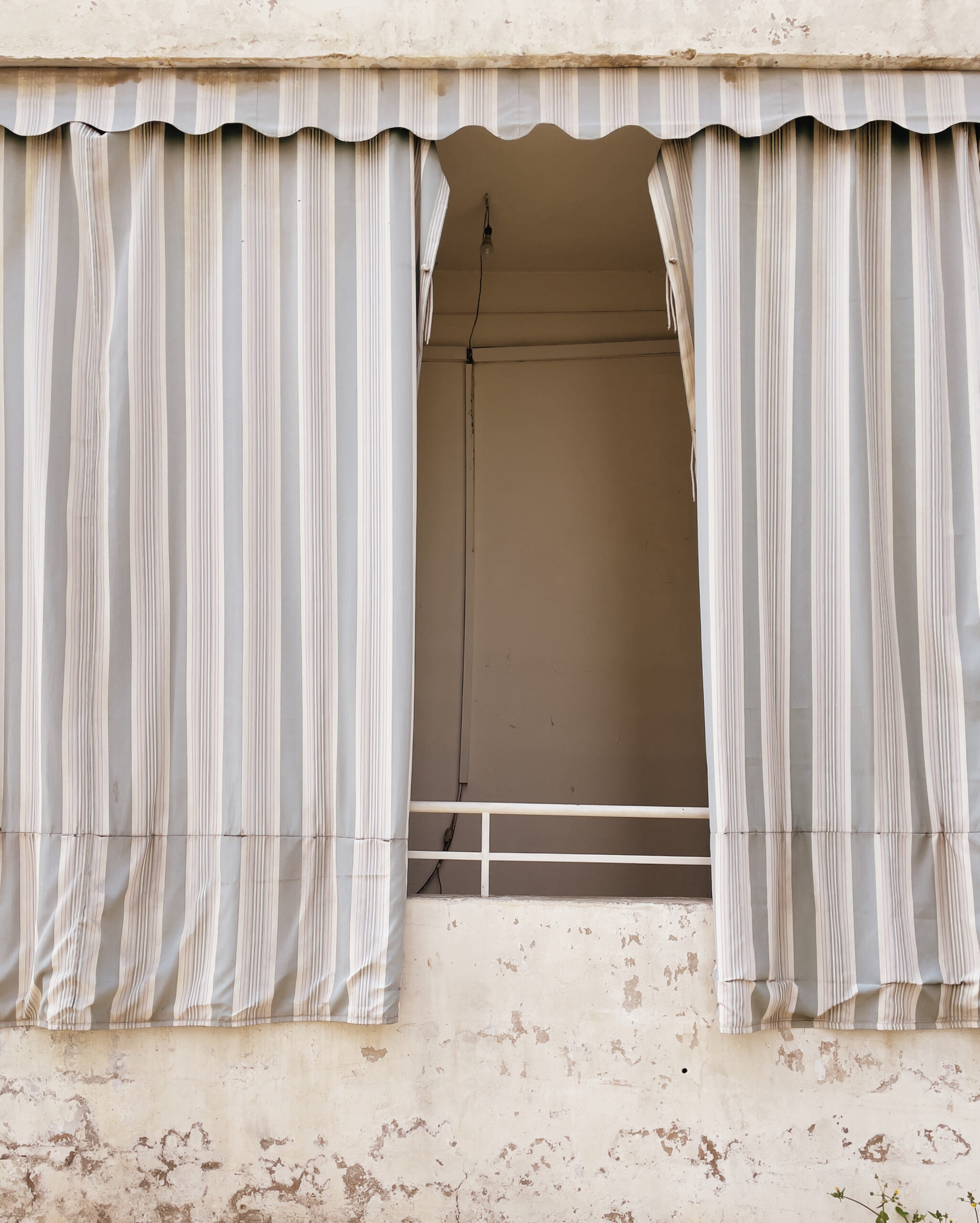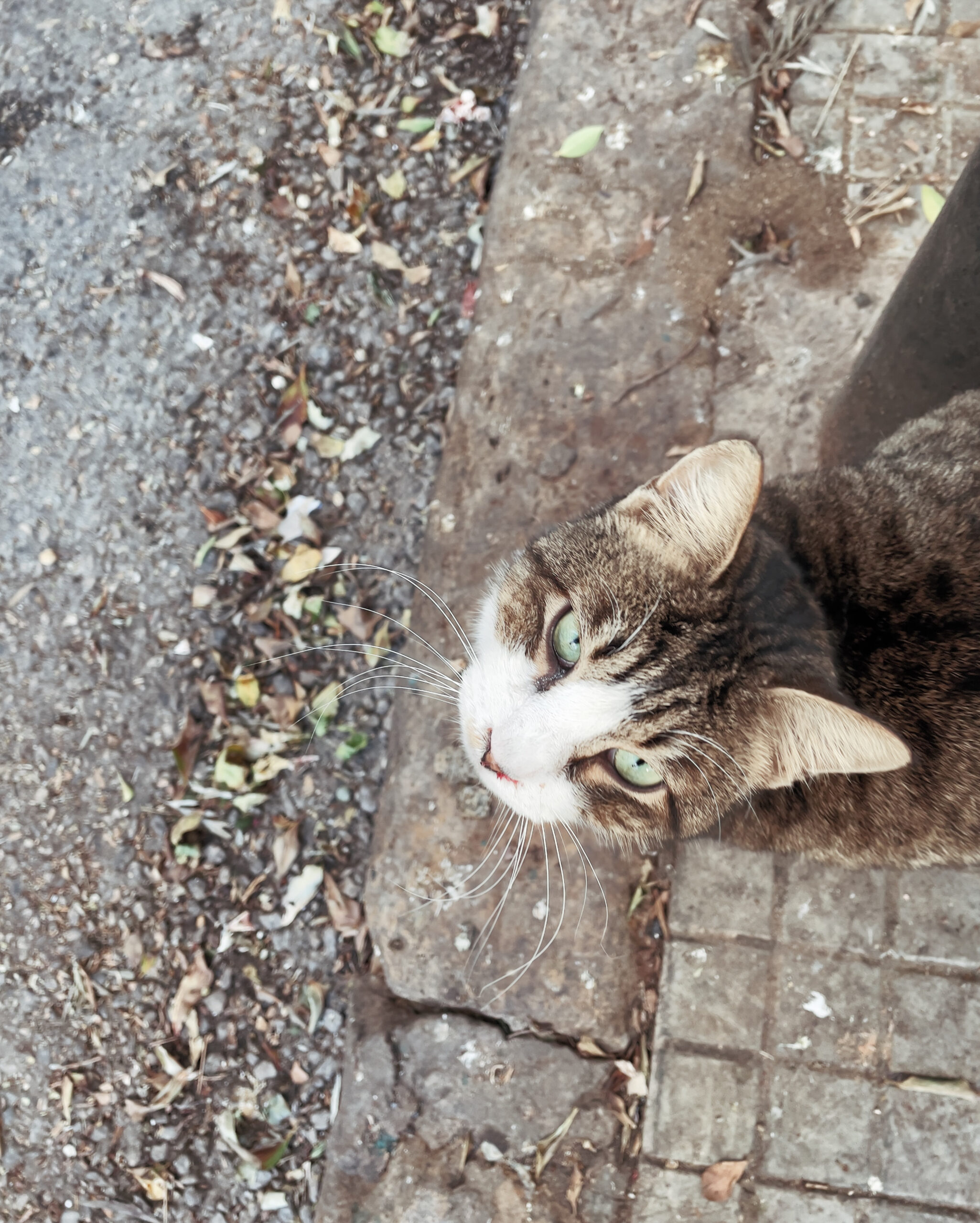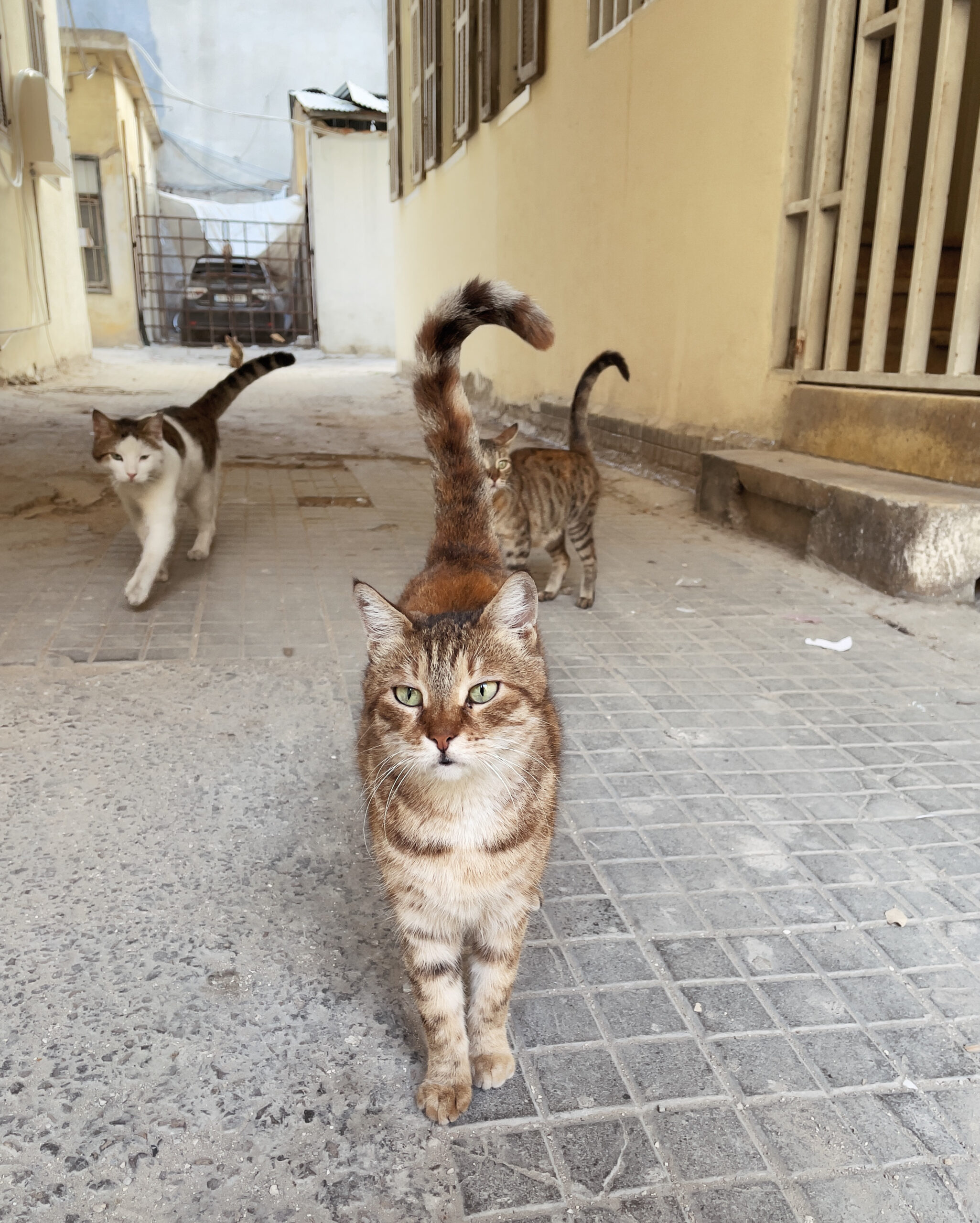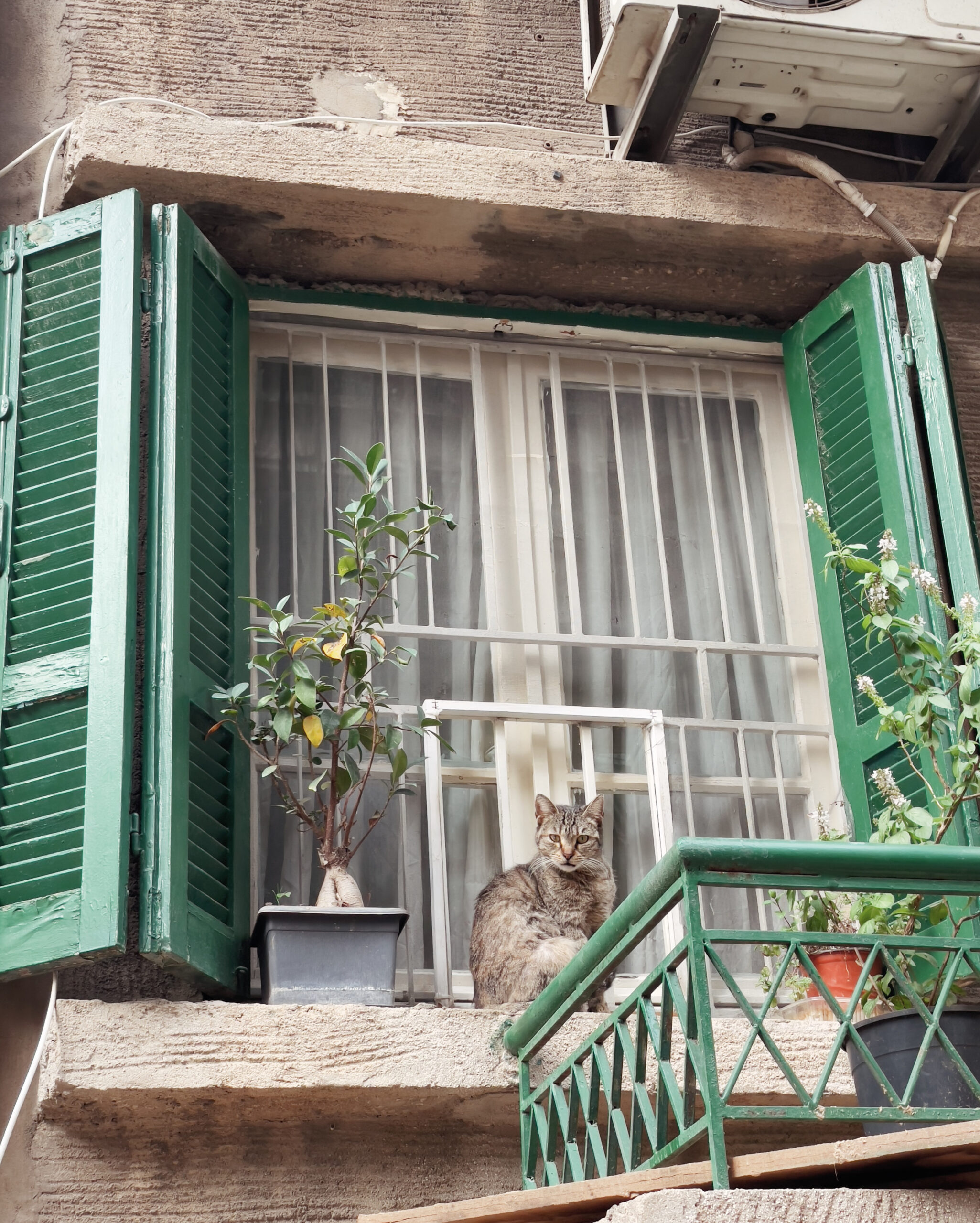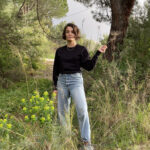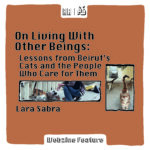"Cats of Beirut" by Tanya Traboulsi
Lessons from Beirut's Cats and the People Who Care for Them
I have lived on Makdissi Street in Beirut since I was born. When I was around 14-years-old, I fell into the habit of taking long solitary walks around the city. The traffic-dense roads and crowded streets were a distraction from the thoughts that filled my head and the worries that dominated my small world: not fitting in at school, a bad grade, falling-out with a friend.
Over the past few years, having participated in an uprising and undergone the subsequent collapse, my walks increased in proportion to the larger anxieties I was facing. I walked to replace the void that was left when the protests died down. I walked to empty my mind, to withdraw from the world.
I walked through alleyways, residential neighborhoods, main streets. I walked past men dragging plastic chairs onto the sidewalk, drinking coffee, talking to one another. Laundry shops, mechanics, hairdressers, and vegetable sellers. Kids yelling and playing. People on streets that all seemed to know each other. They called out to each other from the doors of their stores and buildings and laughed loudly. Laundry hanging from the balconies. But with my headphones on and my gaze fixed straight ahead, I became anonymous and separate from my surroundings.
When the pandemic lockdown began in 2020, I would still go out on walks, but I found that the city had irrevocably changed, and I could no longer connect in the same way to my favorite spots and walkways. The streets were empty and silent. My sole company were the stray cats, and it was as though we were the last inhabitants of a deserted town. As I walked down my usual route, I would see the cats sitting calmly in the middle of the roads. There were no passing vehicles for them to fear.
I looked around to understand what was left for me in this place, and the city revealed itself to me in a new way. I was drawn to people, places, things that I had not previously noticed. Pigeons flying above the city, choreographed by old men from the rooftops of their apartments. Sea waves, laden with waste. Street cats lingering around the same spots every day. I abandoned my headphones to listen to the sounds that emerged from the silence of the city – birdsong, the rustling of the leaves, the echoing of the adhan on city walls.
Looking closely, paying attention, revealed visible cracks in the city’s landscape and in its altered and deadened atmosphere. Cracks in the concrete of sidewalks where flowers grow. Cracks in the urban fabric that have become monotonous and suffocating, in the life of dejection and isolation to which we have become accustomed. Cracks from which new connections to our surroundings can spring. By “cracks,” I mean small spaces of life that are alternative to the degradation and the deterioration the city and the population is facing. They are traces of life in a place that seems and feels dead.
*
One afternoon, I was on a walk in Ain el Mreisseh when I came across a white cat creeping along the sidewalk. The cat’s body was shrunken, skinny, and bony. His fur was streaked with gray dirt. He moved slowly, looked up at me, and meowed croakily. The sight arose in me a mixture of disgust and pity, and I was not sure what to do other than look at him. Beside the cat, there were two containers of dry cat food and one makeshift bowl of water, made from a cut-out bottom of a one liter plastic water bottle, set on the corner of the sidewalk. A black and white cat, healthy-looking, was sipping from the water bowl.
A woman in her mid-fifties was lingering outside a storefront. She approached me timidly, pointing to the white cat, “Isn’t it awful? He’s sick, and I can’t help him. He won’t eat anything. He only eats wet food.”
I pulled out a can of wet cat food from my bag.
“I have this, will he eat it?”
“Yes, this is better, it’s soft! But why do you have it?”
“I feed cats sometimes.” I told her that I am a master’s student doing research on cat-human relationships in Beirut.
“Bya’mlo hasanat,” she said knowingly. “God will bless you if you feed the cats – if you do it from your heart. You will see.”
She inched closer to me, blue eyes widening. In a lower voice she confided, “Before the explosion I was standing near the front of the store, leaning against the glass door at the entrance. Suddenly, I heard a meowing from across the street. I went to look, and there was a small kitten there. I rushed quickly into the store to get food for her. I keep a can of cat food in my drawer for emergencies. As I leaned down to feed her, I heard the explosion. It was the loudest sound I had ever heard. I turned around and the whole store was destroyed, the door was gone, the glass was everywhere like knives… And I never saw that kitten again. Can you believe it?”
She paused and looked me straight in the eye. I shook my head slowly. “If I hadn’t heard the kitten,” she continued, “if I hadn’t gone to feed her, something serious could have happened to me. I was standing right next to the glass door, leaning against it. I would have died.”
She dabbed the corner of her eyes with a tissue. With an abrupt change in tone, she said, “You should come here at 9 a.m. to see how the cats follow me to the store every morning, after I feed them. Tolleh!”
I agreed to pass by, and we warmly exchanged goodbyes. I left without knowing her name.
*
I am often confronted with a feeling, a deep yearning to make the world stop. I felt it in July 2020, when news spread that a man had shot himself in front of Dunkin’ Donuts on Hamra. I felt it again after August 4. Since then, the feeling has been replaced by an amazed disbelief at the capacity of the world to move on without stopping, at my own ability to carry on as if nothing has happened, again and again.
The shopkeeper’s story mystified me and stayed with me for a long time after. Perhaps its mystifying quality stemmed from her readiness to attend to the world, to listen and allow the meowing of the cat to move her, to stick out to her from the cacophony of noises that make the city: the honking of cars, the constant hum of a thousand generators, the construction.
This form of attentiveness can evoke new relationships with our surroundings. The city that I had seen as deadened and suffocating transformed before my eyes. The abandoned wasteland or parking lot became a hosting ground for cats and other living creatures. The terrace of a closed-down restaurant turned into a site for cat homes and feeding stations, with shelters made from cardboard boxes and rags, and water bowls out of plastic bottles.
Objects that we throw away – old sofas, desk chairs, car tires, styrofoam, cardboard, fabric – have been reassembled to create shelters for the cats that roam our streets. They are set up in the middle of sidewalks, on a space on the side of the road. But if we don’t pay attention, we can pass them by, mistaking them for another pile of trash.
*
A week after I first met the shopkeeper, I passed by her shop one afternoon to say hello. She was outside when I reached her store and greeted me enthusiastically when she first saw me, introducing herself as Mona. There were several cats eating from the bowls of cat food, which were nearly empty, set out on the sidewalk. As I watched her refill the bowls, grumbling about how quickly the cats finish them, I asked, “Do you ever get tired of doing this? Do you ever want to stop?”
“What do you think?” she laughed. “What I feel is even worse than depression… If a cat dies, or goes missing, it takes me five or six months just to accept it or forget. I don’t know why I’m like this. On Sunday,” she continued, “I don’t go out to feed them because I am busy cleaning the house. It’s my only day off, and I spend the whole day thinking to myself: Did anyone feed them? I get lost in my thoughts. ’Andi ikta’ab.”
Later that afternoon when we said goodbye, she said affectionately, “Come by anytime…” And then, in a more serious tone, “You have a weak heart, you need to be careful with the cats.”
*
What Mona is speaking to is the reality of relationships, the inevitability of loss. The dangers of attachment.
I know that danger well: It has been the source of my fear of people – of others – and my anxiety towards friendship. I have blamed it for my propensity towards loneliness since my early teens.
*
I used to think of the world as an ordered, regular place where relationships are supposed to be clear and easy. “Are we friends? Is this a friendship?” I would often want to ask people, the same way a child sitting in the backseat of a car impatiently asks his parents if they have reached their destination.
If it took too long, I did not want it. I expected companionship to be easy, I did not want to work for it. Most of all I thought relationships were meant to be fully satisfying and painless, devoid of any discomfort: just one unintentional hurtful comment was enough to make me retreat.
Entering the world of cats in Beirut has ruptured everything that I thought I understood about 'caring' or relationships. The cat-feeders willfully feed the strays twice a day, every day, rain or shine, in sickness or in health. They sustain their caring practices despite the emotional and physical exhaustion. The cats are routinely exposed to sickness, malnutrition, and countless dangers. The danger of pain and loss is thus intrinsically attached to the practice of cat-caring. This is made even harder to handle with the heightening levels of deterioration in the city at large: the cat-feeders do not just expose themselves to animal suffering and pain, they are also in pain themselves as inhabitants of a collapsing city. The cat-feeders live a messy life, one of discomfort. But they somehow find it in themselves to manage the disturbances, frustrations, and misery that accompany what they do.
Their senses become imbricated with those of the cats. I watch them go about their daily feeding routes as the smells of the cats and the odor of cat food enter their skin, impossible to wash away. The smell remains. I watch the rashes, infections, vomit, mucus of the cats stain their clothes and hands. I watch them feed cats on streets where sewage pipes have burst, I watch queasily as the cats drink from black water. I watch them deal with the snarls and hisses of the cats and with the disdainful remarks of people who pass them by.
The cats and their human caretakers help me see the world in its messiness and indecipherability, in its violence and sadness. Watching them reveals to me the inevitable intertwinement of joy and pain, of care and neglect, of companionship and loss, how you can’t have one without risking the other. This is how attentivity unmasks the world.
Through their concentrated attentiveness towards their surroundings, the cat-feeders show me that there is no escaping this world of relationship, of others, despite its dangers and pains. Being attentive entails understanding that we share the world with beings who are irrevocably different from us. It makes us embrace the world in its otherness.
I release myself from the illusory expectation of order. I try to embrace the fear of pain, disappointment, loss, the frightening inevitability that I might make a mistake. I make peace with the terrifying possibility that I might be the recipient of unrequited care, love, friendship.
Loss and pain are inevitable, in our daily lives and in our relationships. What I have been struggling with is finding a way to respond that is not predicated on fleeing from sorrow and heartbreak or normalizing tragedy and violence. The cat-feeders inspire me to imagine new and alternative responses that make space for care, grief, complexity, and ambiguity.
*
The cat-feeders’ inclination to feed the street cats depends on their ability to conceptualize and improvise alternatives. Their activities speak to what anthropologist Ghassan Hage calls an “alter-politics”: a politics that grows not from opposition to our current systems but from attention to another way of being. For the cat-feeders, this “other way of being” involves other living beings. Such politics provide tools which may help us think about new or alternative responses to destruction and collapse.
Cat-feeders have created or retrieved a way of life from a place of scarcity. They make use of what is available to them to create a shared and cooperative life with the stray cats. Instead of stopping at just imagining or “demanding” a better life, they build this life in their everyday encounters, making their imaginations a reality.
The cat-feeders teach me how to be attentive to what surrounds me, directing me towards a way of being that is predicated on curiosity rather than rigidity. Through observing them, I stop looking back woefully at better times or looking eagerly ahead towards a fictional better future. Instead, I allow myself to become attuned to the present, to what surrounds me and what is currently available to me. There, I find richness and plentitude. In a time of diminished political imagination and numbed political life, the cat-feeders help me imagine different ways of living with and through crisis.




